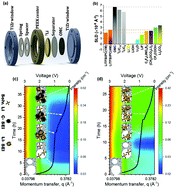Probing microstructure and electrolyte concentration dependent cell chemistry via operando small angle neutron scattering†
Abstract
The key to understanding the cycling mechanism of lithium-ion battery electrodes is to develop methods to monitor the dynamic cell chemistry, but the complexity of the problem has continued to pose an obstacle. Here we describe the use of operando small-angle neutron scattering (SANS) to show directly how the use of concentrated LiTFSI electrolyte in Li/ordered mesoporous carbon (OMC) half-cells influences the mechanism of solid electrolyte interphase (SEI) formation, lithium intercalation, and carbon framework expansion. We find that a complex interplay between the viscosity, lithium solvation shell and electrode microstructure in the concentrated 4 M electrolyte changes the dynamics of SEI formation and pore filling at a given applied potential. Both the filling of micropores and co-intercalation are found to drive the expansion of the carbon framework. Lithium-rich reduction products form at much higher potentials in the micropores of the 4 M electrolyte system, while on mesopore surfaces the lithium-rich salts form quickly before giving way to carbonaceous products. This study reveals operando SANS as a unique method for providing microstructure dependent information on the dynamics of electrochemical processes.



 Please wait while we load your content...
Please wait while we load your content...